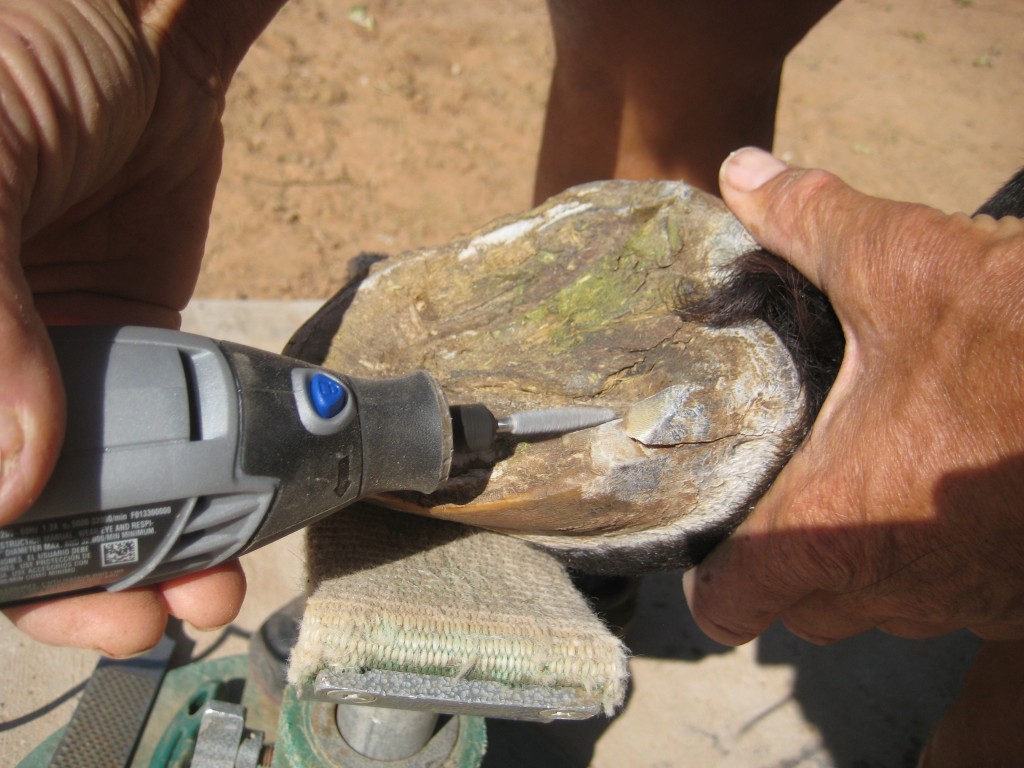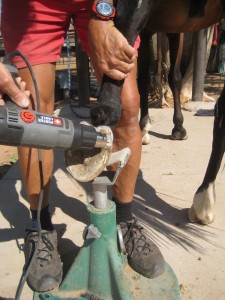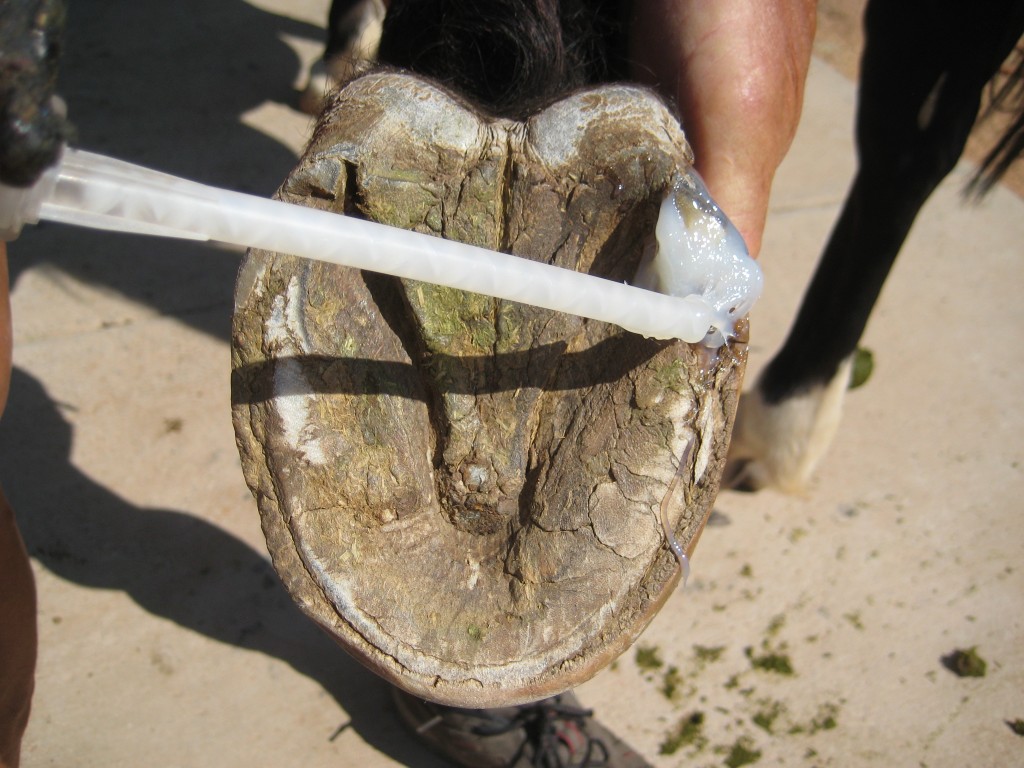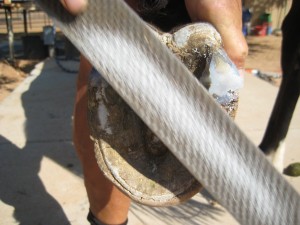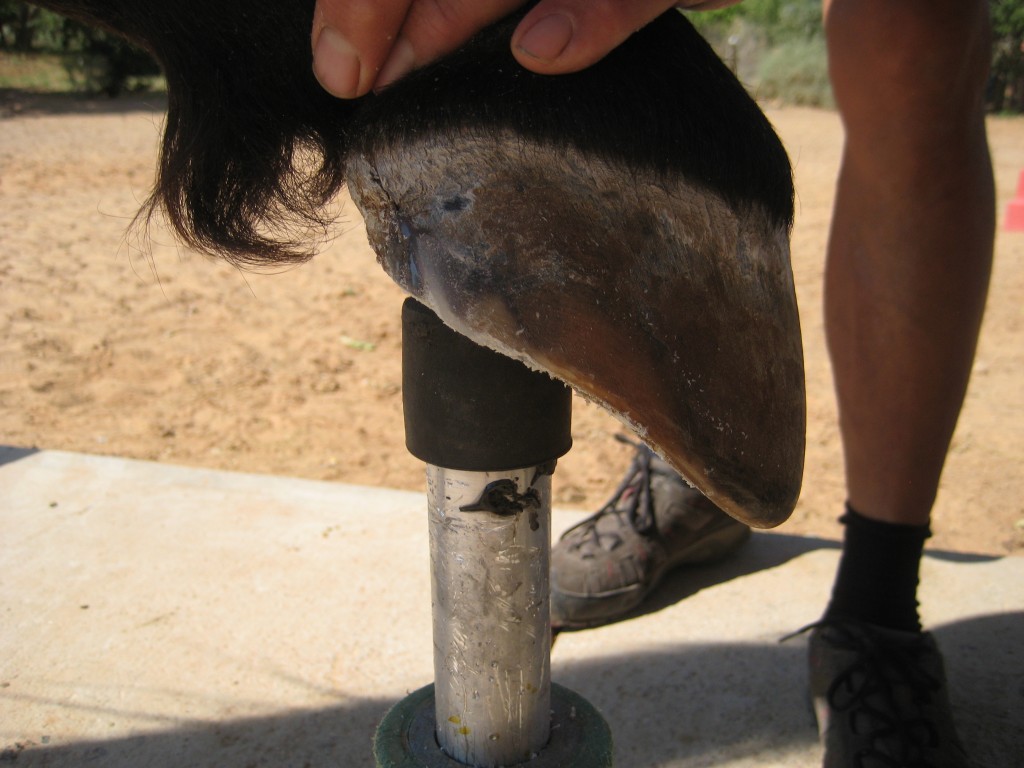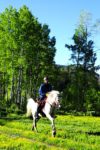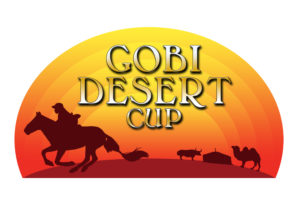Antelope 100: a foreign visitors view.
Veit Koppe from Germany ( SKMBT_C25313062708130 ) spent 3 weeks at GETC this spring. The Highlight was his attendance at the Antelope Two Day 100 in April. He wrote down his experiences in a German Endurance Magazine. The original report is enclosed and can be read by clicking on the inserted SKMBT link above. It is written in German language.
Hoof crack repair
Hoof Cracks happen! Sometimes through imbalanced hooves, load factors, a bad step or an injury.
We always want to explore and find out why these cracks happen, so we can take the necessary remedies or precaution the next time to prevent them.
This hoof crack in the heel was caused by an accident.
First consideration: Patching or leaving it alone. Leaving it as is, we run the risk that some rock might wedge into it and widen the crack. Forces on the heel could also push the heel even more under.
Patching can be done very easily with Vettec Superfast.
First, however, we prepare the hoof and crack for it. For the Vettec Glue to stick, we need to clean, roughen and dry the crack and surrounding area.
A Dremel tool works best for cleaning and roughening the area.
Drying the affected area is next. A heat gun works well.
Next, we apply Vettec Superfast liberally in and around the crack.
After waiting about 5 minutes, we can start rasping off the excess glue material.
The crack is now patched, the horse can resume his normal work routine.
If done properly, these Vettec glues can hold a crack together for months or till it is all grown out.
Another tip from the Global Endurance Training Center
by
Christoph Schork
The UltrOZ
Tendon and suspensory injuries, muscle tear, muscle cramps, splints, bone chips, bruises, inflammations, the list for possible horse injuries seems endless sometimes.
Long rehab therapies are often required, many trips to the veterinarian for treatments. It can be all too frustrating.
At Global Endurance Training Center we have had experience with many different treatment methods and therapies. When we find a good product that gives us results and has been proven, we let you know on our website and through our blogs. If we are convinced of the benefit of any products, tack included, we include them in our on line store. Everything we offer there, we are using ourselves on our horses. These products have been tested by us and proven to be of benefit to horse owners and riders.
Most of us have heard of the healing effects of Ultrasound waves. Till now, these machines were expensive and only larger clinics had them available. With UltrOZ this has changed. Now every horse owner and trainer can treat their horses with their own Ultrasound machine.
The benefits of ultrasound lie in its interaction with cells and tissues. The affects of acoustic vibrations on the body were studied as early as the 6th century AD. Ultrasound gained widespread acceptance as a therapeutic treatment in the 1940’s even though many people today only recognize ultrasound for imaging. Ultrasound therapy has always been attractive because it is completely non-invasive and non-pharmaceutical.
Ultrasound therapy sends a compression wave into the body which exerts a physical force on the tissue, blood vessels, and bones. This compression wave produces the well known benefit of deap heating, but it also increases circulation and flexibility in the area by pushing/pulling nutrients through the cellular structures. This highly dynamic environment is perfect for helping areas recover after activity or heal after an injury
Ultrasound has traditionally been applied in short, high intensity bursts from large systems. However, current research indicates that low heat, long term ultrasound treatments provide an overall better therapy by fully saturating an area and creating a sustained environment for enhanced healing
Longer term treatments mean the increased blood flow and heat is maintained throughout long recovery periods. The body gets more of the nutrients it needs directly where it needs them.
Developed by researchers at Cornell University, UltrOZ Elite makes an effective and well regarded therapy easy to use. No more active administration, no more large machines!
Attaching the device is quick and easy. Simply place the device near the injury using the specially engineered neoprene wraps and ultrasound gel. Turn the device on and therapy begins. Estimated preparation time is 5 minutes or less. Treatment times range 3 – 5 hours without any active supervision required.
Ultrasound therapy is scientifically proven to increase healing and provide pain relief. You cannot over-treat with UltrOZ and internal fail safes prevent thermal injury risk. UltrOZ Elite is a safe, easy to use system for daily treatment of frustrating injuries.
After applying Ultrasound gel to the probe, turn it around and lay it onto the area to be treated. It is advisable to shave the hair off the area where you are placing the probe.
Apply the wrap and insert the transmitter into the pouch after turning it on.
Close the pouch and now you can turn your horse out. Batteries last 5 to 6 hours. Treatment should last at least one hour, often more is better.
If turning your horse out, you can secure the unit with additional vetrap.
Secured like this, you can actually even go for a ride while the UltraOZ is doing its job.
You can use the UltraOZ on all parts of the body. Using it on the hind quarters or shoulders, you can secure it with duct tape or some other tape. In that case, it is advised to keep the horse tied up for the duration, so it does not roll with the device attached.
We have been using UltraOZ now for several weeks on some of our horses with new and old tendon injuries, windpuffs and tight muscles. The results have been truly astonishing. Rehab time is shortened considerably. Within minutes of application, we do notice signs of tension release by the horses: chewing actions, licking lips, blinking the eye. We were impressed!
And the best thing: It is absolutely safe for the horses. You cannot do any damage, even if you forget to take it off and the batteries run empty.
UltraOZ is now available for purchase through Global Endurance Training Center.
Call us or email us with any orders or questions. Here are a couple of links for you to watch to learn more about UltraOz applications.
And another excellent video with detailed demonstrations on how to apply the UltraOZ
The complete unit comes with the transmitter, the probe, a battery charger, 2 wraps, a bottle of ultrasound gel.
This whole system sells for $ 1295.00. Available now at Global Endurance Training Center.
Through the month of May 2012, you will receive a FREE Sore No More Gelotion with each order.
Orders are being taken by calling 435 719 4033, by emailing us at: info@globalendurance.com or by ordering through our website.
Asymetry anyone?
“Do you know that your martingales are only on one side?”
On many endurance events, observant and well meaning crew, fellow riders and spectators remind the riders of Global Endurance Center of the fact that their running martingales are on one side of the reins.
Indeed, they are!
Nice symmetrical martingales, but is this arrangement always practical?
What are the reasons for this symmetry? Is it for looks or function?
Riding with symmetrical martingales certainly has it’s place in the arena. But it does not give us any advantages on the trail, on endurance or conditioning rides.
When flexing and bending a horse, symmetrical martingales only allow a flexing of about 45 degrees on each side. After that angle is reached, the opposing martingale will inhibit any further bending by counteracting and preventing the outside of the neck to stretch any further. Just imagine, if you had a difficult horse, a run away or bolt. It would be very hard to bend or circle the horse enough to gain control.
Quite different is the situation with the one sided or asymmetrical martingales.
Now the rider can bend the horse equally and unrestricted on both sides.
One might wonder why we use martingales in the first place.
Martingales have been used in dressage and many other equestrian disciplines to encourage collection and also preventing sudden head tossing by the horses in training or when getting spooked.
Unrestricted bending laterally
Flexing at the poll
When using martingales, it is important to follow these two rules:
-Always use rein stoppers.
-The length of the martingale need to be the proper length: in line with the straight reins from the bit through the hand and elbow of the rider.
If used without rein stoppers, the metal rings can easily catch on the rings of the rein clips, thus creating havoc for the horse and possibly flipping the horse backwards.
Martingales that are too long do not serve any purpose. If they are too short, the reins will get bend downwards, impeding the communication between the horse’s mouth (bit) and the rider. Furthermore, it can over-flex the poll, hindering proper breathing and compromising performance.
Here, the martingale is too short, causing a kink in the reins, thus interrupting the direct line of communication. Hands, elbow and shoulders are in great position otherwise.
Straight line from bit through hands, elbow and shoulders (there can be a small bend at the elbow, depending on the situation)
Nice hand and elbow position on this rider
During endurance rides, you may want to switch the sides of the running martingale. Half of the riding time, place both rings on the left side, the other half on the right side.
If you want to condition one side of the horse more than the other, then select the side accordingly. Let’s say that you train a horse that is left side dominant but you want to strengthen and build up the right side. Placing the rings of the martingale on the left side of the reins will make it easier to shorten that side, lengthen the right side of the neck and shoulder and encourages the horse to take the right lead.
At Global Endurance Training Center we found the use of running martingale very beneficial for most horses, especially during training and conditioning rides. Applied and used properly, it is a very useful tool.
Christoph Schork
from GETC
Teeth and Hooves
What do they have in common?
At first sight, teeth and hooves of horses seem to be as unrelated as it gets. Comparing them anatomically, could it be that there are, however, common elements?
| Hooves | Teeth | |
| Growth Period: | lifelong | lifelong |
| Speed: | 5 – 8 mm per month | 2 -3 mm per year |
| Trimming: | 2 – 8 weeks | 6 – 12 months |
| Material: | hard outside/soft inside
hoof wall/sole |
hard outside/soft inside
enamel/dentin |
| Functional Comparison | ||
| toes | incisors | |
| quarters and heels | molars | |
| frog | tongue | |
| sole | lower jaw | |
Neglected molars (compare to high heels and lateral flares in hooves)
It is getting interesting, when comparing teeth pathology with hoof pathology.
On this 16 year old gelding, we are observing a left descending ‘smile’ and misalignment with upper and lower jaw.
Photo below shows the effects on the posture of this horse:
the head is carried higher on the left side, left shoulder is elevated, slight flex to the right, front left leg turned out.
Right front is bearing weight on the M/L plane evenly, while the left hoof is loaded on the medial heel, resulting in possibly crushed heels and a lateral flare.
Even small changes in the angles and occlusions of the teeth influencing the jaw, the whole skeleton, tendons, ligaments and muscles of the horse.
Hoof care might as well start with proper teeth care. So many anatomical parts of the horse are interrelated and when we are solely looking at the hooves, we might just manage the same problem everytime without ever getting to the cause and root of the problem.
Regular dental check ups are vital not only for the horses health and digestion, but also for the soundness and proper hoof balance and growth.
This coming year, Global Endurance Training Center will be conducting more studies and comparing teeth pathologies with hoof pathologies and development. We are also very curious if we can find any connection between teeth abnormalities and club feet, teeth and scelletal and muscle changes. We will keep you posted on our findings.
Christoph Schork
The Staff at GETC wishes all our readers a Merry Christmas and successful New Year filled with fun and happiness with all your horses and other animals.
Christoph Schork and Dian Woodward
Teeth and Hooves
What do they have in common?
At first sight, teeth and hooves of horses seem to be as unrelated as it gets. Comparing them anatomically, could it be that there are, however, common elements?
Hooves Teeth
Growth period lifelong lifelong
Speed: 5 – 8 mm a month 2 -3 mm a year
Trimming: 2 – 8 weeks 6 – 12 month
Material: hard outside/soft inside hard outside, soft inside
Hoof wall/sole Enamel/dentin
Growth: from the inside outwards/ from the inside outwards/
out of integument and corium out of the pulp
Functional
comparison: toes incisors
quarters and heels molars
frog tongue
sole lower jaw
Neglected molars (compare to high heels and lateral flares in hooves)
It is getting interesting, when comparing teeth pathology with hoof pathology.
On this 16 year old gelding, we are observing a left descending ‘smile’ and misalignment with upper and lower jaw.
Photo below shows the effects on the posture of this horse:
the head is carried higher on the left side, left shoulder is elevated, slight flex to the right, front left leg turned out.
Right front is bearing weight on the M/L plane evenly, while the left hoof is loaded on the medial heel, resulting in possibly crushed heels and a lateral flare.
Even small changes in the angles and occlusions of the teeth influencing the jaw, the whole skeleton, tendons, ligaments and muscles of the horse.
Hoof care might as well start with proper teeth care. So many anatomical parts of the horse are interrelated and when we are solely looking at the hooves, we might just manage the same problem everytime without ever getting to the cause and root of the problem.
Regular dental check ups are vital not only for the horses health and digestion, but also for the soundness and proper hoof balance and growth.
This coming year, Global Endurance Training Center will be conducting more studies and comparing teeth pathologies with hoof pathologies and development. We are also very curious if we can find any connection between teeth abnormalities and club feet, teeth and scelletal and muscle changes. We will keep you posted on our findings.
Christoph Schork
The Staff at GETC wishes all our readers a Merry Christmas and successful New Year filled with fun and happiness with all your horses and other animals.
Christoph Schork and Dian Woodward
Hoof Care Workshop
This is an event.
Working together
Moab, a resort town in southeastern Utah is well known worldwide for its National Parks, (Arches and Canyonlands), the stunning red rock sand stone formations with natural bridges and arches, its famous white water on the Colorado, like Cataract Canyon and Westwater, the classical western movies filmed here in the 50ies and 60ies and lately for the vast trail system of mountain bike trails. The famous slick rock trail is known among mountain bikers everywhere. No other state has more public trails than the state of Utah and a very large amount of these public trails are within the greater Moab area.
Photo credit: Patitucci Photo
Professor Valley, Moab.
Moab got its name from the ancient land east of the Dead Sea. Nowadays within the state of Jordan. This area also displays red sand stone rock formations, canyons and deserts.

Global Endurance Training Center opened this training facility in this area not only because of its stunning scenery, but also because of that vast trail system, ideal for conditionning endurance horses.
Trails are ever diminishing in the USA. Therefore AERC has an active trails committee, trails advocate are working hard to keep equestrian trails open. But horse people are not an island. Trails users of all kind need to work together to keep trails open and create new ones for hikers, runners, bikers, horse riders and, yes, for motorized travelers as well. Trails get closed for motor bikes first, then mountain bikes, then horses, then foot travel. We all loose. Don’t kidd yourself, a trail closed for motorbikes is a loss for the horse riders as well.
Endurance riders/racers in particular, need more trails than many other trail users. We do have the most at stake. At Global Endurance Center we see the dangers and we are doing everything we can to work on trail issues locally.
The trails within the Moab area attract many people with a multitude of transportation means and tools. Where there are multi use trails, there are inevitably conflicts.
Being proactive, the county community created a unique Committee, Trail Mix, a group of interested trail users and advocates, who meets monthly to discuss trail usage, maintenance, problems, new trail proposals. This group consists of trail advocates for:
-Hikers/runners
-Skiers
-Mountain bikers
-Road bikers
-Equestrians, endurance riders and Backcountry Horsemen
Representatives of BLM, National Forest Service, National Park Service and Motorized Trail Users are joining these meetings to work together for the benefit of trails and trail users.
Example of a motorized trail user.
Global Endurance Training Center has for many years supported Trail Mix and Christoph is a committee member representing all equestrian activities.
TrailMix of Grand County, Utah, could be a model for the national trail problems we are encountering across the country. Here in Grand County, we are not only keeping trails open, we are constantly planning new trails,opening new trails, mapping and maintaining them. Every year, we are increasing the vast network of trails. Equestrians alone could not do it, only the joint effort of all trail users is getting these results.
Here is just one example of maps, here for mountain bikers and motorized travel:
The key is to work together, to learn and understand each others desires and needs. Because of TrailMix, all trail users work together in harmony and respect each other on the trails.
At GETC, we ride and train horses every day of the week. We cover hundreds of miles on our horses. I cannot even remember the last time we had a trail conflict with a biker or motorbike, it just doesn’t happen anymore.
Happy trail users: Dian and Starlit Way
Trail conflicts do not need to happen. We are all in the same boat: diminishing trails everywhere.
Let’s work together to stop that and create more trails. TrailMix can be a national example for cooperation.
Contact us if you want more info on TrailMix or trail cooperation.
info@globalendurance.com
Sensational !!
Global Endurance Training Center is proud to announce that as of last month, we are distributors of the Sensation Treeless Saddles.
Christoph riding a Sensation Westlish saddle on his mare, Stars Aflame, at the National 100 Mile AERC Championship to a First Place Win and receiving the BC Award.
With so many treeless saddles on the market now, why did we choose to add the the Sensation Saddle line to our inventory?
You can count on the quality. Sensations are designed in Canada, and made in Canada. The materials are primarily North American, and all the leather comes from Canada or the USA. All saddles are made with quality leather designed to last you thousands of miles of comfort.
The quality of the workmanship, the stitching seen here, is superb.
Your Horse, of Course. Sensations are the only treeless saddle design to utilize a multi-point stirrup attachment. This means better weight distribution for your horse, particularly important when you’re riding long and hard. When your Sensation saddle is set up in the hard use or endurance attachments, you can count on having an even better weight distribution than a treed saddle. Taking the tree out of a saddle doesn’t make it a treeless saddle – thoughtful engineering and a redesigned weight distribution system allows it to be a true treeless saddle, and not just a bareback pad with stirrups.
The stirrups can get hung precicly where you want them, you can adjust them to your personal needs and alignment.
Here the G4 stirrup adjustment. You may use any of the three billets as stirrup hanger, the other two will serve for the girth.
Choices, Choices, Choices. Break traditions! Each Sensation Saddle is custom made to suit your needs. Who says you can only ride in black and brown saddles? Who says you have to ride English or Western? You can choose the components you like best and combine them to create your perfect saddle. Be flashy, go with Hot Pink if that’s what you like. Every horse and rider is different and Sensation offers a wide variety of options in Leather, Seat Size, Flap shape, cantle and pommel sizes, rigging adjustments, etc. We want to ensure you have the best saddle to suit YOUR needs, and almost anything is possible.
Here the Sensation Westlish Rebel saddle on Baloo Bit O Honey, customized red seat and knee rolls. The leather is so soft, that Christoph is able to ride 50 miles in shorts on it without getting any rubbing on his legs.
The Sensation Harmony Element saddly, with customized fleece seat.
Complete Comfort and connection. The Sensation Ride saddles have been ergonomically designed to permit the rider a close contact, balanced (yet customizable) seat using medical grade foams, high grade custom felts, wool and leather. These same materials allow air flow through the saddle’s layers; breathability is important to the comfort of you and your horse, and we believe that neoprene and rubbers just don’t perform in a way that permits exhaustion of heat and moisture. The Sensation saddles will mould to you and your horse. No hard parts in our saddles! The saddle will form fit to you like a fine new leather shoe.
G4 Westlish Rebel Sensation saddle fits horse and rider: riding in synergy. (Christoph on Stars Aflame)
Uphill during the championship race
Did you know that..
Sensation Ride saddles have the best weight distribution system in the treeless saddle world? This is important for keeping the rider’s weight from being concentrated over a small area at any time during the rider’s position.
Sensation Ride saddle owners are using their saddles for: Assisted riding therapy, endurance, dressage, back country treks, jumping, hunting, competitive trail, gaited riding, starting youngsters, reining, gymkhana & more!
The Sensation G4 Western Sport Trail saddle. All Sensation saddles are equipped with the pommel strap for easy one hand carrying. Useful as well for attaching essential gear. Or mayby holding onto occasionally when riding a bronc.
The same model mounted on Stars Aflame
Global Endurance Training Center has now the following Sensation saddles in stock:
15.5 inch G3 Hybrid
16 inch G4 Western Trail, displayed here with HAF pad
Both saddles are available right now. For a complete saddle line up and for ordering and customizing your Sensation saddle, contact us at Global Endurance Training Center:
Tel 435 719 4033 or
Email: info@globalendurance.com.
On average, it will take about 6 weeks after ordering your saddle before you can ride and enjoy it.
Global Endurance Center also distributes Freeform saddles and Specialized saddles. Specialized saddles are treed saddles that can get fine tuned to the horses back through a system of foam wedges. More info available through our website as well.
GETC offers this variety of saddles, treeless and with tree, to cover any saddle needs you might have, so you and your horse can ride in total comfort.
We provide ongoing consultation and advice to find the right saddle for you and your horse.
Enjoy the Ride!

